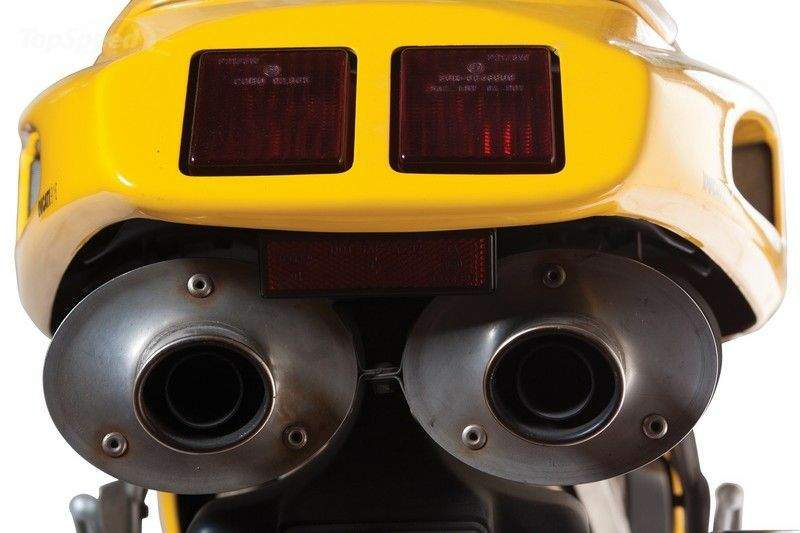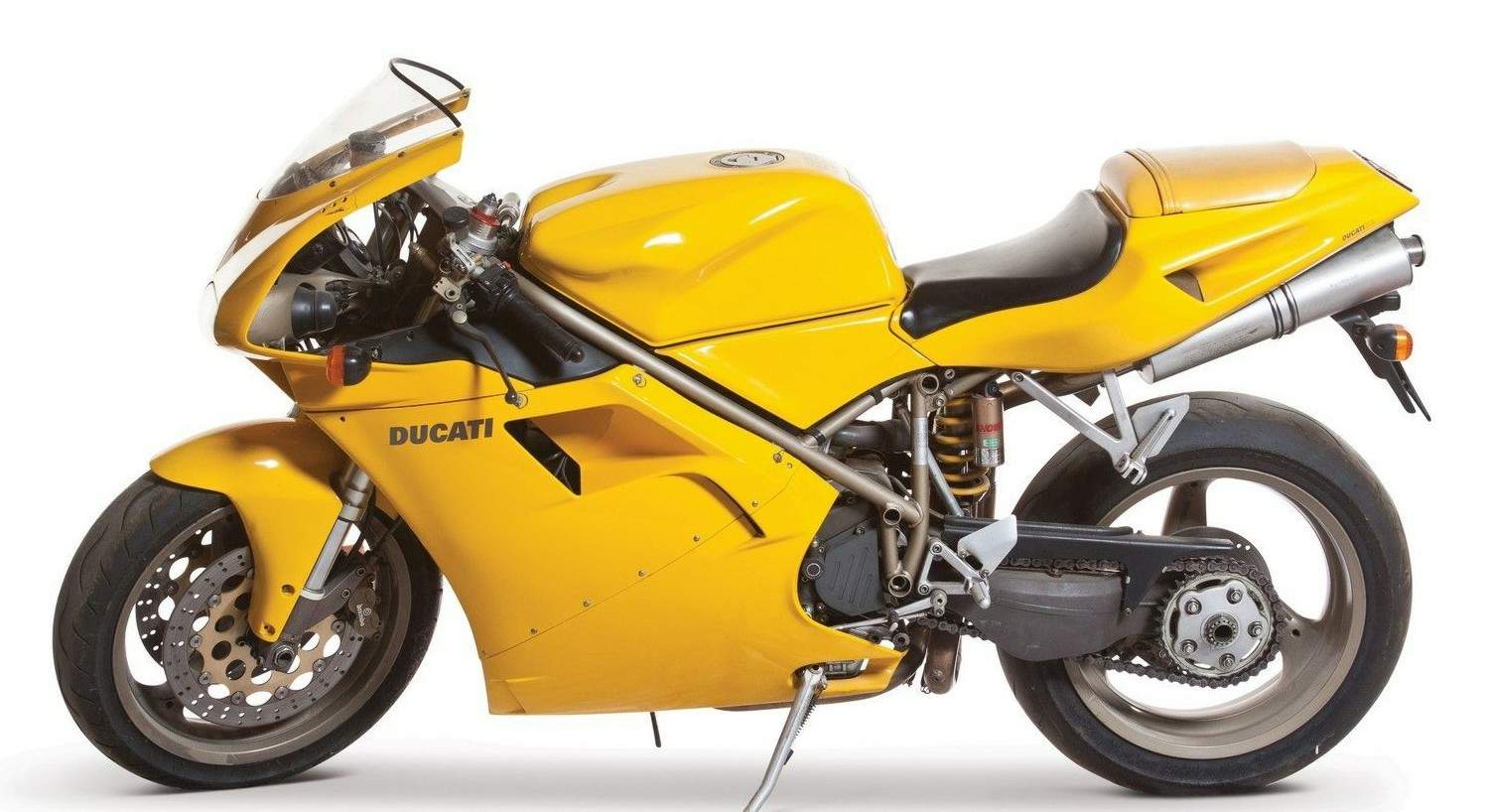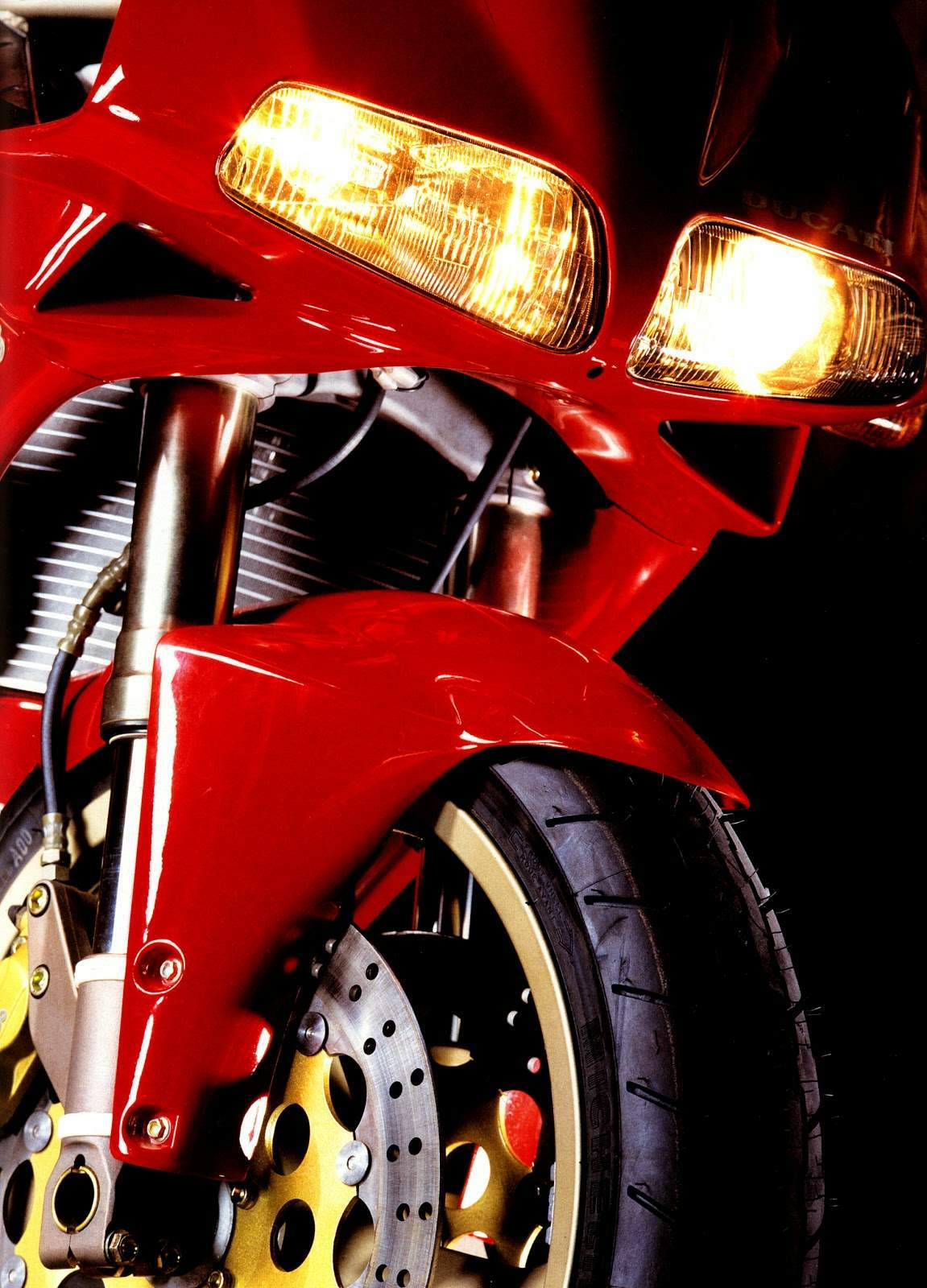
|
|
|
|
|
|
Classic Bikes
Custom Bikes
Individual
Racing Bikes AJP
AJS
Aprilia
Ariel
Avinton / Wakan
Bajaj
Benelli
Beta
Bimota
BMW
Brough Superior
BRP Cam-Am
BSA
Buell / EBR
Bultaco
Cagiva
Campagna
CCM
CF Moto
Combat Motors
Derbi
Deus
Ducati
Excelsior
GASGAS
Ghezzi Brian
Gilera
GIMA
Harley Davidson
Hero
Highland
Honda
Horex
Husaberg
Husqvarna
Hyosung
Indian
Jawa
Kawasaki
KTM
KYMCO
Laverda
Lazareth
Magni
Maico
Mash
Matchless
Mondial
Moto Guzzi
Moto Morini
MV Agusta
MZ / MuZ
NCR
Norton
NSU
Paton
Peugeot
Piaggio
Revival Cycles
Roland Sands
Royal Enfield
Sachs
Sherco
Sunbeam
Suzuki
SWM
SYM
Triumph
TVS
Ural
Velocette
Vespa
Victory
Vincent
VOR
Voxan
Vyrus
Walt Siegl
Walz
Wrenchmonkees
Wunderlich
XTR / Radical
Yamaha
Zero
Video
Technical
Complete Manufacturer List
|
Ducati 916
|
|
Make Model |
Ducati 916 |
|
Year |
1998 |
|
Engine |
Four stroke, 90° “L” twin cylinder, DOHC, desmodromic 4 valve per cylinder, belt driven |
|
Capacity |
916 cc / 55.9 cu in |
| Bore x Stroke | 94 x 66 mm |
| Cooling System | Liquid cooled |
| Compression Ratio | 11.0:1 |
|
Induction |
Weber I.A.W. CPU P8 electronic indirect injection |
| Spark Plugs | Champion RA59GC |
| Lubrication | Wet sump |
| Engine Oil | Synthetic, 15w-50 |
|
Ignition |
Electronic I.A.W |
| Battery | 12V 16Ah |
| Starting | Electric |
|
Max Power |
83.8 kW / 114 hp @ 9000 rpm |
|
Max Torque |
90 Nm / 9 kgf-m / 66.3 lb-ft @ 7000 rpm |
|
Clutch |
Dry, multiplate |
|
Transmission |
6 Speed |
| Primary Drive Ratio | 2:1 (31/62) |
| Gear Ratios | 1st 2.466 / 2nd 1.765 / 3rd 1.350 / 4th 1.091 / 5th 0.958 / 6th 0.857 |
| Final Drive Ratio | 2.4:1 (15/36) |
| Final Drive | Chain |
| Frame | Steel, Trellis frame |
|
Front Suspension |
43 mm Adjustable Showa GD051 inverted fork |
| Front Wheel Travel | 127 mm / 5.0 in |
|
Rear Suspension |
Showa GD52-007-02, rising rate progressive linkage adjustable monoshock |
| Rear Wheel Travel | 130 mm / 5.1 in |
|
Front Brakes |
2 x 320 mm Discs, 4 piston calipers |
|
Rear Brakes |
Single 220 disc, 2 piston caliper |
|
Front Wheel |
3.50 x 17 |
|
RearWheel |
5.50 x 17 |
|
Front Tyre |
120/70 ZR17 |
|
Rear Tyre |
190/50 ZR17 or 180/55 ZR17 |
| Rake | Adjustable 24o - 25o |
| Trail | 94 - 100 mm / 3.7 - 3.9 in |
|
Dimensions |
Length 2050 mm / 80.7 in Width 685 mm / 27.0 in Height 1090 mm / 42.9 in |
| Wheelbase | 1410 mm / 56.6 in |
| Seat Height | 790 mm / 31.1 in |
|
Dry Weight |
198 kg / 436 lbs |
| Wet Weight | 204 kg / 450 lbs |
|
Fuel Capacity |
17 Litres / 4.4 US gal / 3.7 Imp gal |
| Reserve | 4 L / 1.1 IS gal / 0.9 Imp gal |
|
Consumption Average |
5.4 L/100 km / 18.5 km/l / 43.5 US mpg / 52.3 Imp mpg |
|
Braking 60 km/h - 0 |
12.9 m / 42.3 ft |
|
Braking 100 km/h - 0 |
39.9 m / 131 ft |
|
Standing ¼ Mile |
10.6 sec / 207.4 km/h / 128.9 mph |
|
Top Speed |
255.1 km/h / 158.5 mph |
| Manual | Ducati 916 Manuals |
| Road Test | Moto Sprint 1994 |
Rarely has a motorcycle combined style and speed to such devastating effect as Ducati's 916. The Italian V-twin's blend of breathtaking beauty, thunderous engine performance and sublime handling made it an instant hit on the bike's launch in 1994. By the end of the decade. 916-based machines had won a string of World Superbike titles. Meanwhile the roadster went from strength to strength, its engine enlarged but its look proudly intact. The 916 was a development of the liquid-cooled, eight-valve desmodromic V-twin line that stretched back to the 851 of 1988. More than simply aerodynamic, designer Massimo Tamburini's creation was inspired. The fairing's sharp nose held aggressive twin headlights. Elegant scarlet shapes were everywhere in the fuel tank and fairing.

The rear end. with its diminutive
tailpiece, high-level silencers and single-sided swingarm, was equally dramatic.
Ducati's 916cc motor was a bored-out version of the unit from the previous 888
model. Other changes included a revised Weber fuel-injection system plus the
addition of a larger, curved radiator. Breathing was uprated with a large airbox
fed by intakes running back from the fairing nose. In combination with a new
exhaust system, this raised the eight-valve motor's peak output by a few
horsepower to 114bhp at 9000rpm.
Chassis design combined Ducati's traditional steel ladder frame with a tubular
aluminium rear subframe. The 916 differed from the 888 by using a second rear
engine mount for extra rigidity. There was nothing traditional about the
aluminium swingarm that curved round the huge 190-section rear tyre before
swooping back to anchor the three-spoke wheel. Tamburini admitted that this was
not the purest engineering solution, but considered the compromise worthwhile
for the boost ii brought to the bike's high-tech image.

Neat engineering
There was more neat engineering a( the steering head, which featured adjustable
geometry plus a horizontally mounted steering damper. More conventionally, the
swingarm worked a vertical. multi-adjustable Showa shock. The Japanese firm also
provided the 43mm upside-down forks, which held a 17-inch from wheel. Braking
was by Brembo. Ducati's eight-valve engine had long been a torquey, charismatic
powcrplanl. and the 916 unit was the best yet. Its mid-range response was
majestic, sending the bike rocketing out of corners from as low as 5000rpm to
the accompaniment of a spine-tingling exhaust growl. High-rev acceleration was
smooth and strong, too. sending the 916 to a top speed of I60mph (257km/h).
Handling was superb, justifying Ducati's decision to slick with a steel frame,
after considering a switch to aluminium. At 4291b (195kg) the 916 was light, its
frame was rigid, and its suspension of high quality. Although the Ducati was not
the quickest-Steering of superbikes. it had a confidence-inspiring blend of
stability and neutral cornering feel.
This most purposeful of Italian sportsters was not always an easy companion, especially in town, where its racy riding position, firm suspension and snatchy power delivery made life unpleasant. On the right road, though, the 916 was simply magical: one of those rare machines that left all those who rode it stunned by its unmatched combination of beauty, character and performance.
Ducati's Superbike Dominance
The roadgoing 916 was a hit in the showrooms, and Ducati's factory racebike of the same name was even more successful in the World Superbike championship. The red V-twins were the dominant force in the most prestigious four-stroke racing series, notably with Carl Fogarty. The British rider won in 1994 and again a year later. Australian ace Troy Corser retained the crown for Ducati in 1996 before Fogarty, who had left for Honda, returned to regain the title in 1998. His fourth championship, in 1999, made it five in six years for the Italian V-twin.
Source of review: Fast Bikes by Roland Brown

|
Any corrections or more information on these motorcycles will be kindly appreciated. |